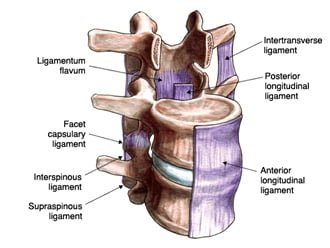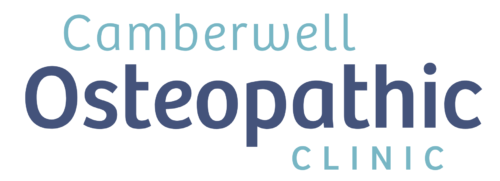The term ‘disc’ can put the fear of God in patients as everyone loves telling a horror story about someone they knew who had a disc complaint. My advice – don’t listen to these people! They are rarely health professionals, they do not know the specifics of your, or their friends injury, and people just love telling horror stories. Today I’d like to clarify some things with regard to disc injuries and lower back pain to reassure you they are not a life sentence and Osteopathy can help!
Patients can sometimes be told they have, or describe their back pain, as a “slipped disc”. A slipped disc is something that sounds quite worrying and no doubt would be a great cause for concern – if it were possible.
Looking at the diagram below showing the spinal anatomy surrounding an intervertebral disc (the light blue structure in between the two verterbral bodies), you can see there are many strong ligaments that hold the disc securely in place. What’s not easy to see in the picture is that the disc is also strongly attached to the vertebral body above and below it making it a very stable structure. You can also see it is a pretty crowded structure. All these spinal structures can be injured or strained or irritated – including the intervertebral disc – to cause back pain.

The strength of all the supporting ligaments means the disc is not going anywhere without some severe trauma to the spine. Which believe it or not is reassuring: your spine is really strong!!! There may be many causes for your, or a loved one’s, back pain but discs “slipping out of place” is not one of them.
A disc bulge or disc injury are simply terms used to describe an injury the disc where the structure has been compromised. And, like most injuries, with appropriate care and management it will get better. As Osteopaths, we regularly treat all types of lower back pain, including disc injuries, and the vast majority resolve fully and the patient returns to a pain-free existence.
When you visit an Osteopath, it is our job to identify what is causing your pain. Your back pain may not even be because of the disc! A thorough case history and examination will be taken and once we form a diagnosis, you’ll usually receive about 20 minutes of hands-on treatment which may include massage, stretching, joint articulation and manipulation.

The good news is, because of the strength of your spine, most back pain does NOT require surgery or intervention. Together we can help get you back on track to your favourite activities and past times free from back pain.




